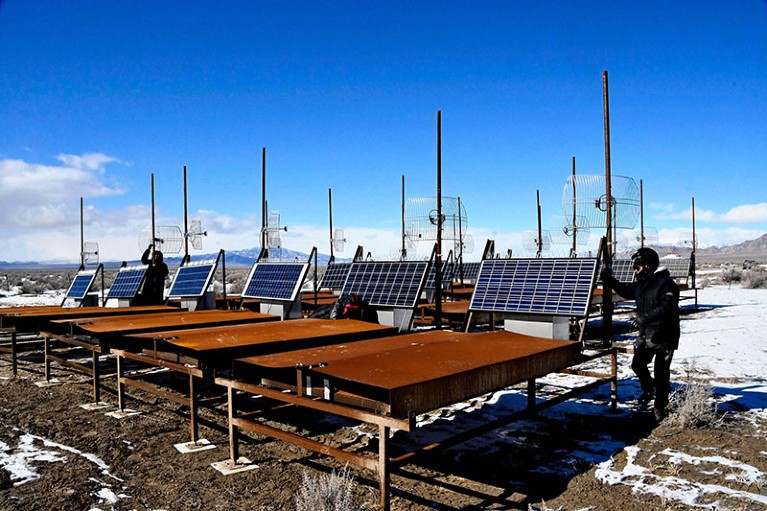
Researchers check the Telescope Array surface detector in the high desert in Delta, Utah, in 2019. In 2021, the Telescope Array detected the second-most energetic cosmic ray particle recorded.Credit: The Yomiuri Shimbun via AP/Alamy
Scientists have detected the most powerful cosmic ray seen in more than three decades. But the exact origin of this turbocharged particle from outer space remains a mystery, with some suggesting that it could have been generated by unknown physics.
The puzzling cosmic ray had an estimated energy of 240 exa-electronvolts (EeV; 1018 electronvolts), making it comparable to the most powerful cosmic ray ever detected, aptly named the Oh-My-God particle, which measured at around 320 EeV when it was discovered in 1991. The findings were published today in Science1.
“It’s amazing because you have to think of what could produce such high energy,” says Clancy James, an astronomer at Curtin University in Perth, Australia.
A cosmic ray, despite its name, is actually a high-energy subatomic particle — often a proton — that zips through space at close to the speed of light. In their ultrahigh-energy form, cosmic rays have energy levels that exceed one EeV, which is around one million times greater than those reached by the most powerful human-made particle accelerators. Cosmic rays with energies of more than 100 EeV are rarely spotted — fewer than one of these particles arrives on each square kilometre of Earth each century.
Not a mistake
Toshihiro Fujii, an astronomer at the Osaka Metropolitan University in Japan, stumbled across some bizarre signals on 27 May 2021, while he was doing a routine data check at the Telescope Array, a cosmic-ray detector in Millard County, Utah. The signals suggested that the facilities’ detectors had been smashed with something super energetic, but he was sceptical at first. “I thought there was some sort of mistake or bug in the software,” says Fujii. “I was really surprised.” But measurements were consistent with those produced by ultra-cosmic rays. The scientists nicknamed the particle ‘Amaterasu’, after a Japanese Sun goddess.
But when Fujii and his team tried to pinpoint the source of the energetic spike, they drew a blank. Ultrahigh-energy cosmic rays usually travel through space relatively smoothly, because they don’t bounce off magnetic fields as strongly as low-energy cosmic rays do. This would have made it easy to pinpoint the stellar explosion, black hole or galaxy that it came from.
But Fujii and his team calculated the source of the ray to be in a void-like region where few galaxies reside. To cover all bases, the researchers also tried matching the cosmic ray with possible source galaxies and objects located just outside its arrival direction. But none of them seemed to fit. “There was nothing,” says Fujii.
One explanation could be that the models estimating how magnetic fields influence the course of cosmic rays are off and could require some tweaking, says James. If that’s the case, it’s possible that Amaterasu might have come from a slightly different direction than the team’s calculations suggest. “We think we’ve got good estimates, but maybe we’re wrong,” says James.
Another possibility is that ultrahigh-energy cosmic rays are produced by unknown physical processes that might enable them to travel much vaster distances than previously thought, says Jose Bellido Caceres, an astroparticle physicist at the University of Adelaide, Australia. “It could be new physics,” says Bellido Caceres, who has worked on the Pierre Auger Observatory in Malargüe, Argentina. He adds that cosmic rays offer a testing ground for exploring how particles interact at extreme energies that cannot be produced by accelerators on Earth.
Fujii and his team are in the process of upgrading the Telescope Array to be four times as sensitive as before. This will allow researchers to capture more of these rare ultrahigh-energy cosmic rays and trace their origins more precisely.

